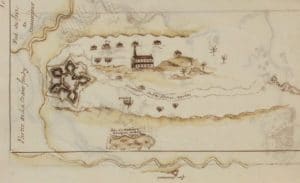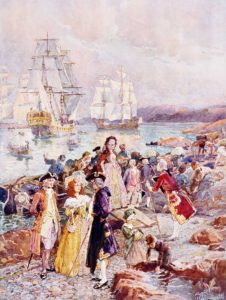
By the early 1700s the French settlements formed a part of the Acadia, a colonial division of New France. Acadia covered what is now the Maritimes, as well as bits of Quebec and Maine. The British conquest of most of the Acadian peninsula occurred during the Queen Anne’s War, and was formalized in the Treaty of Utrecht of 1713. After the war, French Acadia was reduced to Île Saint-Jean (Prince Edward Island) and Île-Royale (Cape Breton Island). The ownership of continental Acadia (New Brunswick) remained disputed, with an informal border on the Isthmus of Chignecto. In an effort to limit British expansion into continental Acadia, the French built Fort Beauséjour at the isthmus in 1751.
From 1749 to 1755, the British engaged in a campaign to consolidate its control over Nova Scotia. The resulting conflict led to an Acadian Exodus to French controlled territories in North America, including portions of continental Acadia. In 1755, the British captured Fort Beauséjour, severing the Acadian supply lines to Nova Scotia, and Île-Royale. Unable to make most of the Acadians sign an unconditional oath of allegiance, British authorities undertook a campaign to expel the Acadians in the initial periods of the Seven Years’ War.
British Colony:
Continental Acadia was eventually incorporated into the British colony of Nova Scotia, with nearly all of New France being surrendered to the British with the Treaty of Paris in 1763. Acadians that returned from exile discovered several thousand immigrants, mostly from New England, on their former lands. Some settled around Memramcook and along the Saint John River. In 1766, settlers from Pennsylvania founded Moncton, and English settlers from Yorkshire arrived in the Sackville area. However, settlement of the area remained slow in the mid 18th century.
After the American Revolution, about 10,000 loyalist refugees settled along the north shore of the Bay of Fundy, commemorated in the province’s motto, Spem reduxit (“hope restored”). The number reached almost 14,000 by 1784, with about one in ten eventually returning to America. New Brunswick was partitioned from Nova Scotia in 1784, and that year saw its first elected assembly. The colony was named New Brunswick in honor of George III, King of Great Britain, King of Ireland, and Prince-elector of Brunswick-Lüneburg in what is now Germany. In 1785, Saint John became Canada’s first incorporated city. The population of the colony reached 26,000 in 1806 and 35,000 in 1812.

The 1800s saw an age of prosperity based on wood export and shipbuilding, bolstered by The Canadian–American Reciprocity Treaty of 1854 and demand from the American Civil War. St. Martins became the third most productive shipbuilding town in the Maritimes, producing over 500 vessels. In 1848, responsible home government was granted and the 1850s saw the emergence of political parties largely organised along religious and ethnic lines. The first half of the 1800s saw large-scale immigration from Ireland and Scotland, with the population reaching 252,047 by 1861.
